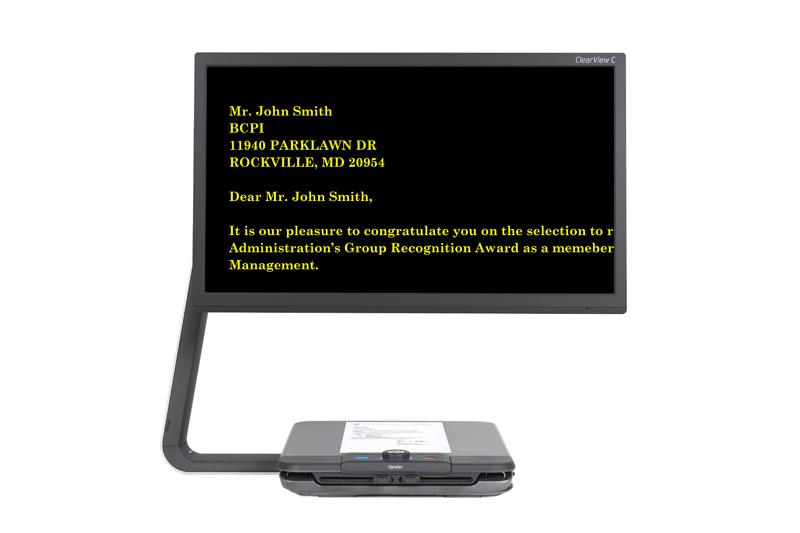Optelec ClearView C Full HD Speech Desktop Magnifier
Optelec ClearView C Full HD Speech Desktop Magnifier
Share
SKU:CVC-OCR-24-BBCC
Out of stock
Couldn't load pickup availability
We accept




The new Optelec ClearView C Speech is a unique desktop video magnifier that is designed to improve your reading experience. Select your preferred reading voice and sit back, relax, and listen to documents as they are read aloud. Combining a clear voice with magnification or high contrast makes reading so much easier.
C-ing without limitations
When we started to develop this desktop video magnifier, we wanted to eliminate all of the difficulties users experienced. After extensive research involving our clients, we came up with a completely new design.
Read long documents with Text-to-Speech
The ClearView C Speech can instantly convert any printed text into speech. It makes it possible to have access to information in a way that is most comfortable and easy to you. Especially long texts are now easy to read.
Point directly at columns or words with Point & Read
To scroll through documents, swipe with your finger on the touch screen and select the text of your interest by simply pointing at a paragraph, column or word. It is that easy.
See the whole page and navigate quickly
The ClearView C Speech displays full pages and automatically identifies the document layout. This ensures that you navigate quickly, you always know where you are and never lose your place.
Store your documents or view your favorite photos
With the ClearView C Speech, you have the freedom to save important letters or books or view your digital photos. Store the documents or view your photos on a SD card or on a USB drive and access them when they are needed.
Choose for comfort and design
The ClearView C is designed to make reading more comfortable and to complement the interior of your home. The high quality materials and sleek design provide a contemporary look that is inviting in any room.
Specifications
- Click Here To Download The User Manual
- Continuous magnification: 1.5X – 75X (optional: up to 170X)
- Superior High Definition 1080p video processing for ultra sharp and vivid images
- 24-inch full color TFT widescreen display
- Point & Read functionality: intuitive touch interface
- Overview: full letter page viewing
- Assistive reading with automatic text zone recognition
- Fast text recognition (OCR)
- Over 60 reading voices in 30 languages
- Saving and opening documents on a SD card or USB stick
- Large icon and large font menu
- Volume control
- Speed control
- Digital photo viewer
- Built-in stereo speakers
- SD card slot
- USB port
- Headphone connector (standard 3.5 mm)
- Adjustable document viewing modes:
- Full color photo mode
- 16 selectable high contrast color combinations to improve contrast for better visibility
- From 1 to 4 selectable color combination presets - Optional: large Comfort table top; ideal for reading larger documents or doing craftwork (see ‘Accessories’)
- Adjustable brightness
- Adjustable contrast
- Overview function
- Focus lock
- Position locator
- Reading lines
- Window / blinds
- Adjustable setup:
- Standard (Compact) setup, ideal for daily use
- Comfort setup, ideal for reading large documents, such as newspapers and doing craftwork - Integrated lighting for even illumination, and elimination of reflections when reading glossy documents
- Easy-glide reading table with X and Y direction adjustable friction and X and Y brake
- PC connection to switch between ClearView C and PC image
- Dimensions base unit footprint: 16.5 in x 20.1 in
- Dimensions XY table: 16.6 in x 16.6 in
- Weight: 18,9 kg / 41.7 lb
Videos


